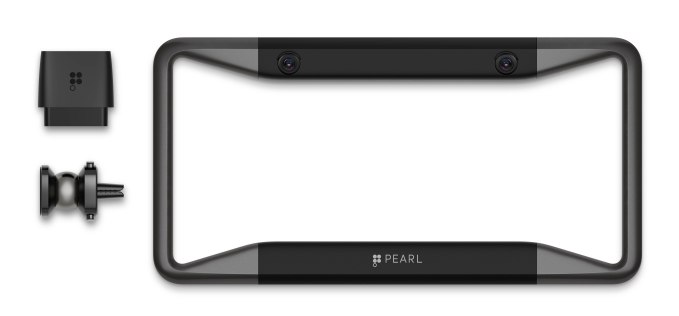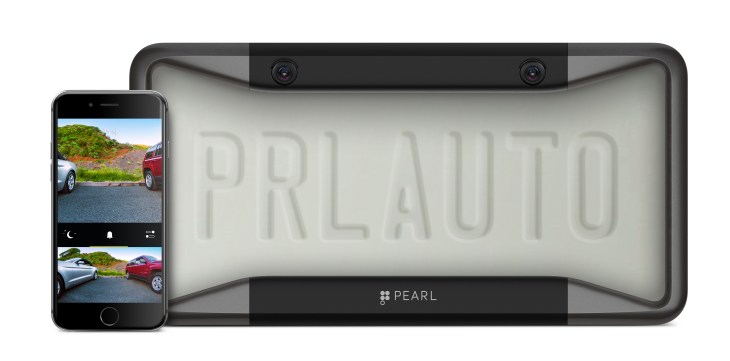Tesla may have created the notion that the tech in every car should be upgradable without buying a new car with its constant software updates — but there still aren’t many Tesla owners out there.
In fact for many car owners it’ll be a pain or expensive to install new technology that you might find in a Tesla car, or even more modern cars, into an older car. That’s why Bryson Gardner — and his team of former Apple executives — decided to start Pearl Automation, which builds tools that can upgrade the technology of a car using new tools and your smartphone. The company is starting off with a rear-view camera, called RearVision, that fits around a license plate, feeding video directly to your smartphone when you back up.
“One of the reasons for that is it’s expensive to make a car platform and it takes that long to recover the cost of everything associated with the car,” Gardner said. “You have this extended timeline in the beginning, once that tech appears in the car it’s really just in the subset of it, higher end and luxury cars. it can take 10 to 20 years to fan out. ”
Here’s the nitty gritty of it: Car owners screw in a new license plate cover that has a pair of cameras. Those cameras sync up to a locally generated Wi-fi network that connects to an adaptor that plugs in under the steering wheel. That data is then fed to your smartphone, so whenever you put the car in reverse, it switches over to the backup camera. It’s a wide-angle camera that gives you a 180-degree view of what’s behind the car. There aren’t any lines on the camera that indicate how far your car goes back, but there are alerts when obstacles — like people — get too close to the car.
Pearl started with a backup camera because, not surprisingly, backup cameras are starting to get rolled out in a lot of new cars. Today around 20% to 25% of cars have backup cameras, which raises awareness for the technology, Gardner said. For example, if a household owns two cars and one has a backup camera, odds are the owner is going to want the other one to have a backup camera as well.

But that technology still takes a long time to roll out. It can take as long as 5-10 years until a new piece of technology starts popping up in new cars, and even then it starts off in higher-end models. Gardner said. The car development cycle is just much longer, which means it takes around half a decade for a major refresh for a car to roll out. That lag means there’s an opportunity to introduce that technology in a simple-to-install manner.
Gardner was originally hired at Apple to manage the first iPod Nano in 2005, and soon picked up the rest of the iPod and started working on the iPhone over the course of his career. That job in particular was an interesting one: It was Apple’s first foray into using flash storage. Apple’s rapid release cycle allowed the company to experiment with new kinds of hardware and technology, something Gardner said he hoped to bring to the automotive industry. So the team formed in 2014, and over the course of its life has raised $50 million in financing across two rounds.
It would seem — and be expected — that a lot of inspiration here is drawn from Tesla, which can essentially install new features on cars with over-the-air software updates. That’s allowed Tesla cars to essentially improve over time without having to go in for upgrades, or requiring the owner to purchase a new car. Sure, eventually the cars themselves will be out of date, but the fact remains that Tesla has shown consumers that cars should improve over time, Gardner said.
“That’s really a new idea in automotive,” he said. “We saw that as well, we also think a lot of the technologies that are being developed in auto are really valuable technologies. Rather than waiting for the future promise to materialize in a new car, we see a lot of opportunity in creating those core techs and creating systems that help the human driver today.”
The product certainly isn’t cheap. It costs around $500 — which, even for installing a backup in an existing car may sound steep. So it’s going to be a challenge to convince consumers, especially given the options to install technology themselves, and with manufacturers catching on to the idea that cars need to have a deeper level of software integration. But the idea is that Pearl’s software will constantly be improving thanks to wireless updates to the adaptor that over time upgrade the technology, much like the software in Tesla vehicles gets updated over time.
“It’s maybe more obvious now that everyone’s talking about it, but almost 2.5 years ago that we started, on the car, it was less obvious at the time what the opportunity was,” Gardner said. “Now I think, what Tesla as proven out from a whole car perspective in turning the car into a software car, there’s a lot of opportunity to take individual features into software solutions. This turns into a hardware-based thing and makes it a software thing.”
